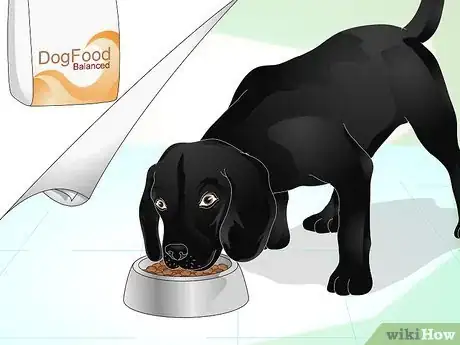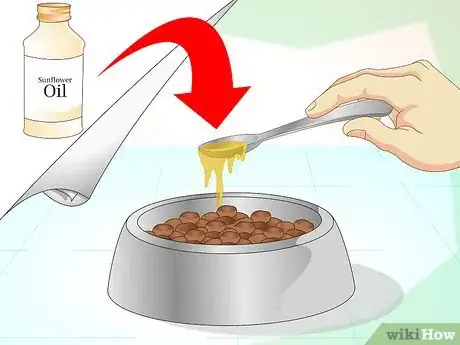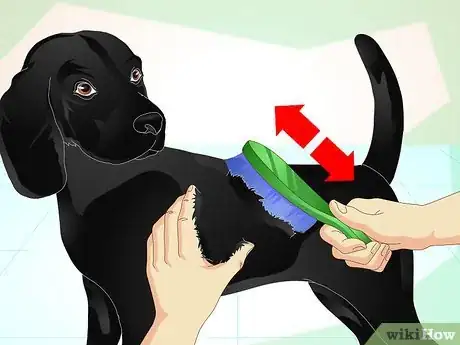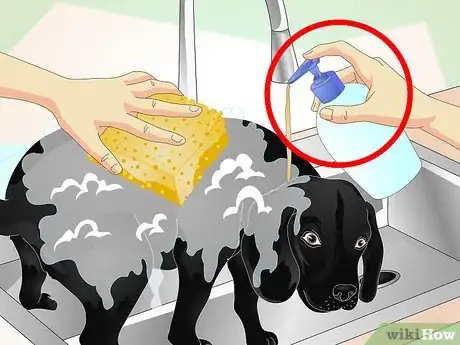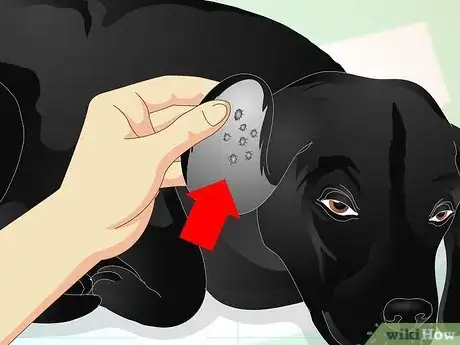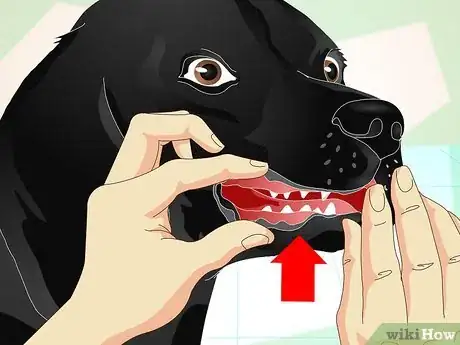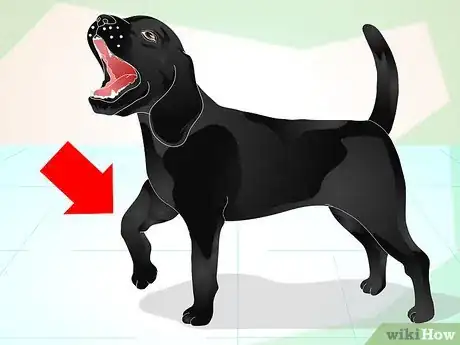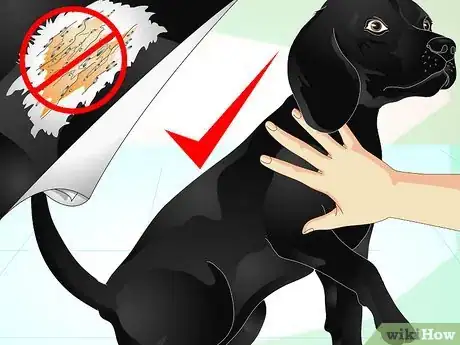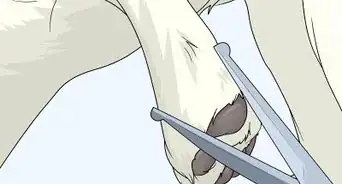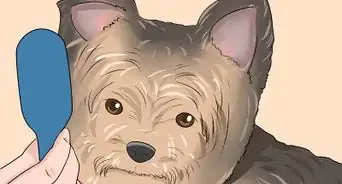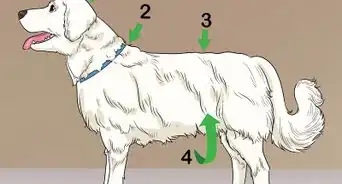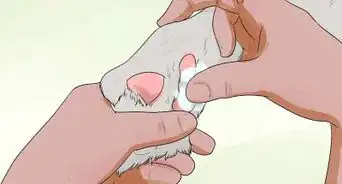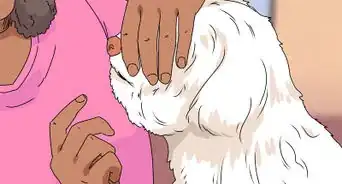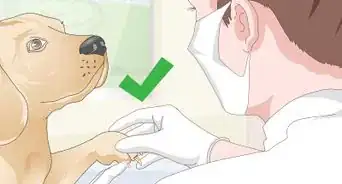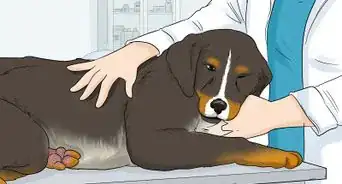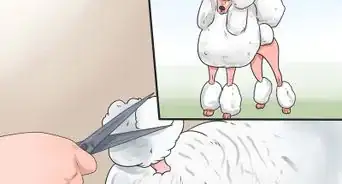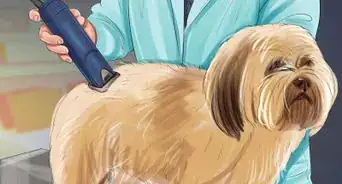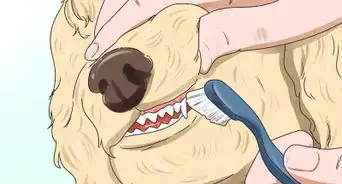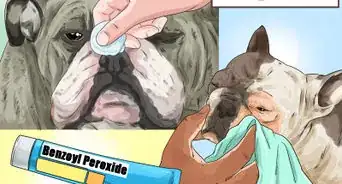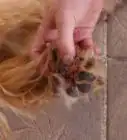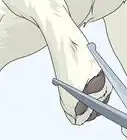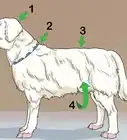This article was co-authored by Marie Lin. Marie Lin is a Licensed Pet Groomer and the Owner of Marie's Pet Grooming, a grooming salon based in New York City. Marie has over 10 years of pet grooming experience specializing in dogs and cats. She earned her pet grooming certification from the American Academy of Pet Grooming New York in 2009 and is also a member of the National Dog Groomers Association of America. She earned a Master of Business Administration (MBA) from Hawaii Pacific University in 2007.
There are 7 references cited in this article, which can be found at the bottom of the page.
wikiHow marks an article as reader-approved once it receives enough positive feedback. This article received 11 testimonials and 98% of readers who voted found it helpful, earning it our reader-approved status.
This article has been viewed 190,008 times.
Your dog's coat is one of the clearest indicators of your dog's overall health. A dull or damaged coat may indicate disease, poor grooming, or parasites. If you've determined that your dog isn't suffering from a medical condition that affects his coat, it's easy to make your dog's coat shine.
Steps
Improving Your Dog's Coat
-
1Feed your dog a healthy and well-balanced diet. If you buy a commercial dog food, make sure it contains the proper balance of nutrients. You may want to ask your vet to recommend a product and dosage specific to your dog. A nutritionally-rich diet is important in maintaining the health and condition of your dog's coat.
- If you choose to make your own dog food, talk with the vet about making sure it's got the right balance of vitamins and minerals. Making your own dog food at home is a great way to be completely sure of what you're feeding your dog.[1]
-
2Supplement your dog's diet with omega fatty acids. Look for an omega-6 supplement or consider adding safflower or sunflower oil to your dog's food. If adding the oil, give 1 teaspoon a day to a small dog or 1 tablespoon a day for a large dog. Avoid giving too much, since it could cause diarrhea. You may also want to give omega-3 fatty acids, which have a greater anti-inflammatory effect. These are found in flaxseed and fish oils. Regardless of the supplement you choose, always follow the packaging for dosage instructions.
- Omega fatty acids can reduce the itchy skin of dogs with allergies, since they have natural anti-inflammatory effects.
- They also nourish the cells that are developing at the deepest layer of your dog's skin. It will take at least 28 days for these skin cells to become the top layer and reveal an extra plush coat, so don't stop supplementing before that time.[2]
Advertisement -
3Groom your dog regularly. You should groom your dog every few days, regardless of whether he has long or short hair. Be sure to use dog brushes and combs, since they're designed to remove tangles, mats, dead skin cells, and dander. You'll need to look for tools that are best suited to your dog's fur. Always brush with the lie of the fur to distribute the natural oils through the hair and use a comb to get rid of tangles.
- Grooming also improves the oxygen supply to your dog's skin. This can improve the health and look of your dog's coat.
- You may want to rub a dry leather chamois over your dog's coat to buff and polish it.
-
4Bathe your dog with the proper shampoo. To avoid stripping the natural oils from your dog's coat, leaving him prone to dryness, only shampoo your dog when they really need it.[3] Choose a shampoo specifically made for dogs and look for one that matches your dog's coat and skin sensitivity. For example, if your dog scratches a lot, you may want to choose a sensitive shampoo or look for one made with oatmeal since oatmeal acts as a natural itch reliever.[4]
- You'll know it's time to bathe your dog when their coat is visibly dirty and they start to smell bad.[5]
- If your dog loves to roll in mud and needs frequent washing, chose the mildest shampoo you can find, preferably one that's moisturizing.
- Be sure to rinse the dog's coat thoroughly. Any residual shampoo or conditioner left in the coat can irritate the skin and make the coat look dull and lifeless.
-
5Check for parasites. Thoroughly look through your dog's coat for parasites, like fleas or ticks, which can affect your dog's coat and overall health. Since ticks are larger and slower, they'll be easier to see than fleas. To check for fleas, run your fingers over several parts of your dog's coat (like behind the ears, down the back, near the tail, and on the belly). Look for small pinpoint-sized black spots, known as flea dirt. These are flea droppings that are usually concentrated in one area.
- You may want the veterinarian to check for worms and other internal parasites. These can feed off your dog and rob him of nutrients, damaging his coat. Your vet can check a fecal sample and prescribe medication to treat your dog.
- One parasite (cheyletiella) is known as "walking dandruff" because it looks like large flakes of dandruff and if you watch carefully you may see it walk. Your vet will check for this and might recommend your dog be sprayed with medication once every two weeks for 2 or 3 treatments.[6]
Identifying Skin and Health Issues
-
1Determine if your dog is unwell. If your dog is sick or feeling nauseous, he may stop grooming. This leads to a dull, unkempt coat and can signal to veterinarians that your dog has a medical condition. Check in with your veterinarian if you notice any one of the following symptoms in your dog:[7]
- Lack of appetite
- Excessive thirst
- Vomiting
- Diarrhea or soft stools
- Smelly Breath
- Smelly ears
- Lameness
- Difficulty Breathing
-
2Check your dog for sore teeth. Sore teeth can make it harder for your dog to eat. As a consequence, he may be messier and get food in his coat. To check for sore teeth, lift your dog's lip and take a look at the teeth and gums. His mouth should look like yours, with white teeth and pink gums. If the teeth are coated in tartar (a white buildup), the teeth are wobbly, or the gums are inflamed and bleeding, then your pet needs veterinary attention.[8]
- You may also notice your dog's breath smells bad and he's a messy eater. If his teeth hurt, he will drop food out of his mouth when he chews. This can contribute to a dirty coat.
-
3Consider if your dog has arthritis. Arthritis, or inflammation of the joints, can cause stiffness and pain. Your dog may be too stiff and sore to easily groom himself. If this is the case, you'll notice your dog walking stiffly and having difficulty using stairs or jumping in a vehicle. You'll need to talk to the veterinarian about medication to treat the pain of arthritis.[9]
- In the meantime, help your dog by grooming him daily. Pay particular attention to areas that your dog can't comfortably reach.
-
4Check to see if your dog has a greasy coat or scaly skin. Pay attention for scaly, dandruff prone skin or an especially greasy coat. Your dog may have a condition called seborrhea, in which the skin's follicles create too much oil. This can trigger skin flaking or dandruff. Your vet will need to determine the cause of the greasy or scaly skin in order to recommend a treatment.[10]
- Your vet may recommend supplementing your dog's diet with vitamin A or zinc to clear up any skin conditions.[11]
Expert Q&A
Did you know you can get expert answers for this article?
Unlock expert answers by supporting wikiHow
-
QuestionCan I put olive oil on my dog?
 Pippa Elliott, MRCVSDr. Elliott, BVMS, MRCVS is a veterinarian with over 30 years of experience in veterinary surgery and companion animal practice. She graduated from the University of Glasgow in 1987 with a degree in veterinary medicine and surgery. She has worked at the same animal clinic in her hometown for over 20 years.
Pippa Elliott, MRCVSDr. Elliott, BVMS, MRCVS is a veterinarian with over 30 years of experience in veterinary surgery and companion animal practice. She graduated from the University of Glasgow in 1987 with a degree in veterinary medicine and surgery. She has worked at the same animal clinic in her hometown for over 20 years.
Veterinarian
-
QuestionCan you put coconut oil on your dog's skin?
 Pippa Elliott, MRCVSDr. Elliott, BVMS, MRCVS is a veterinarian with over 30 years of experience in veterinary surgery and companion animal practice. She graduated from the University of Glasgow in 1987 with a degree in veterinary medicine and surgery. She has worked at the same animal clinic in her hometown for over 20 years.
Pippa Elliott, MRCVSDr. Elliott, BVMS, MRCVS is a veterinarian with over 30 years of experience in veterinary surgery and companion animal practice. She graduated from the University of Glasgow in 1987 with a degree in veterinary medicine and surgery. She has worked at the same animal clinic in her hometown for over 20 years.
Veterinarian
-
QuestionCan you use hair conditioner on a dog?
 Pippa Elliott, MRCVSDr. Elliott, BVMS, MRCVS is a veterinarian with over 30 years of experience in veterinary surgery and companion animal practice. She graduated from the University of Glasgow in 1987 with a degree in veterinary medicine and surgery. She has worked at the same animal clinic in her hometown for over 20 years.
Pippa Elliott, MRCVSDr. Elliott, BVMS, MRCVS is a veterinarian with over 30 years of experience in veterinary surgery and companion animal practice. She graduated from the University of Glasgow in 1987 with a degree in veterinary medicine and surgery. She has worked at the same animal clinic in her hometown for over 20 years.
Veterinarian
References
- ↑ https://www.cesarsway.com/dog-care/nutrition/dog-nutrition-a-to-z
- ↑ http://pets.webmd.com/dogs/guide/dog-nutrition-for-a-healthy-coat
- ↑ Marie Lin. Licensed Pet Groomer. Expert Interview. 2 November 2020.
- ↑ https://www.aspca.org/pet-care/virtual-pet-behaviorist/dog-behavior/bathing-your-dog
- ↑ Marie Lin. Licensed Pet Groomer. Expert Interview. 2 November 2020.
- ↑ http://www.petmd.com/dog/conditions/skin/c_multi_cheyletiellosis
- ↑ http://www.healthline.com/health-slideshow/9-warning-signs-dog-needs-veterinarian#1
- ↑ Small Animal Internal Medicine. Nelson & Couto. Mosby.
- ↑ Small Animal Internal Medicine. Nelson & Couto. Mosby.
About This Article
To make a dog's coat shine, feed it a healthy and nutritionally-rich diet. You can also add an omega-6 supplement to your dog's diet to help it develop plush, shiny fur. Groom your dog at least 1-2 times per week, or more often if it has long fur, using brushes and combs designed for dogs. Always brush in the direction of hair growth to distribute the natural oils and add a healthy sheen to the coat. Shampoo your dog no more than once a month using shampoo formulated for dogs. For tips on checking for parasites and other issues, read on!
